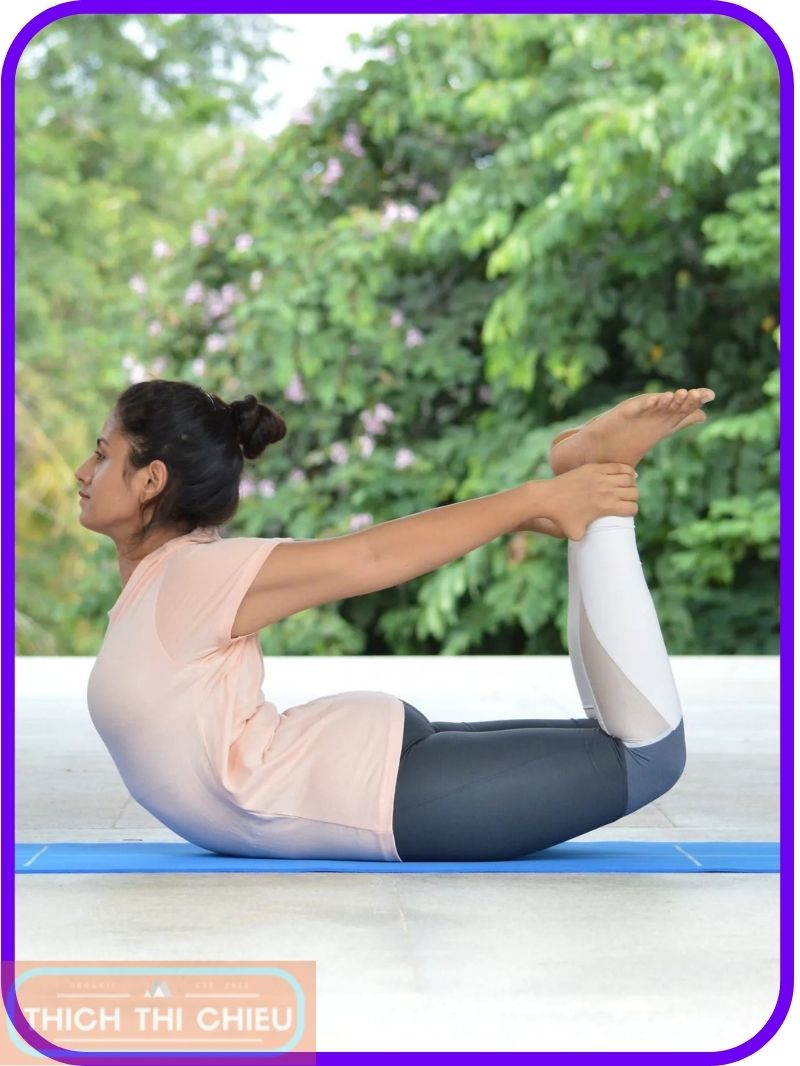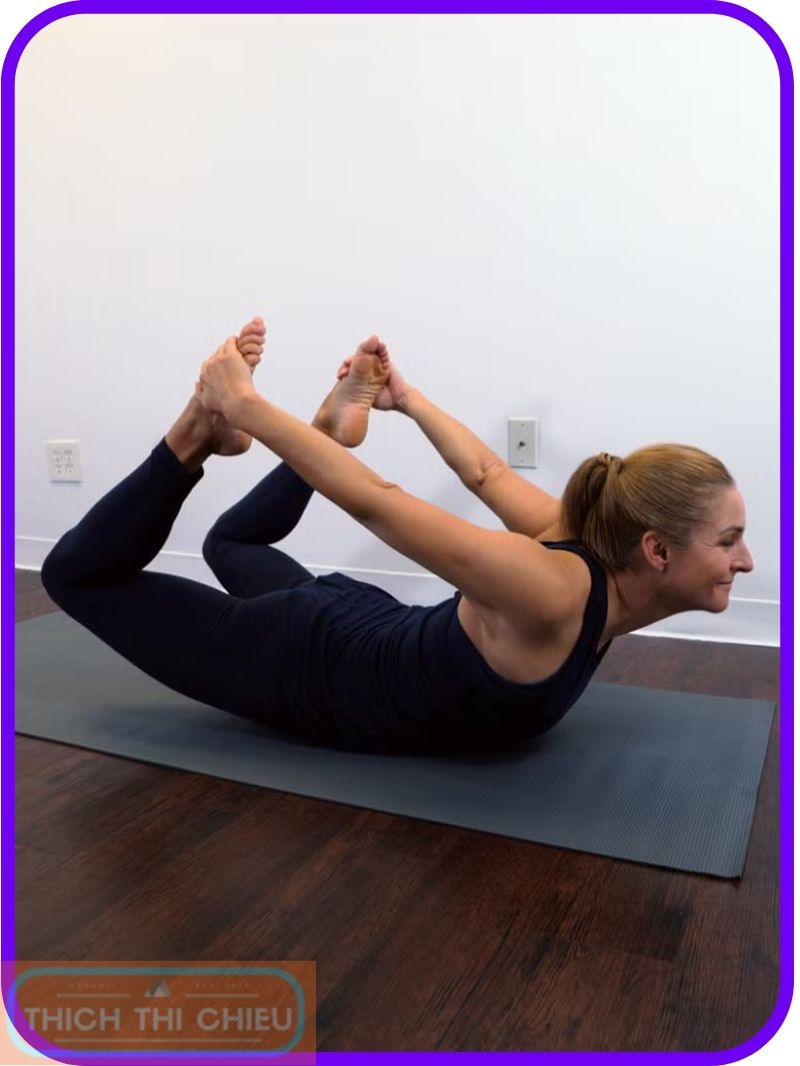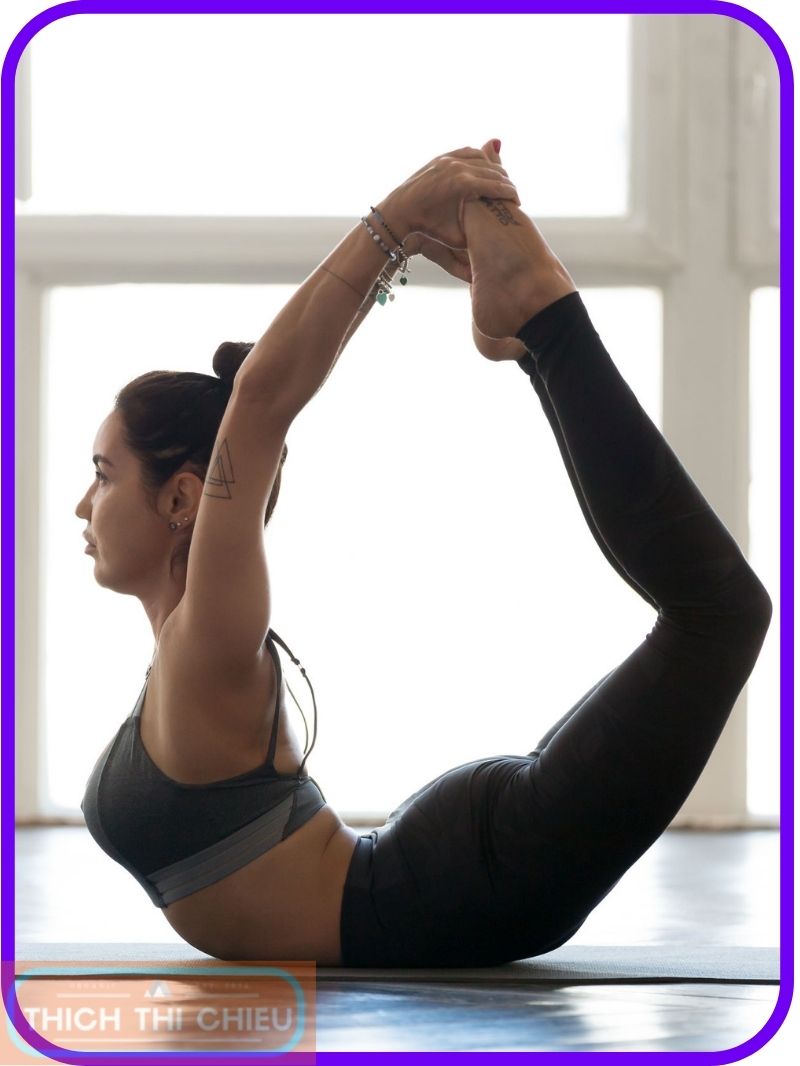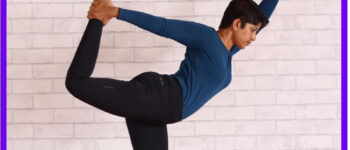Dhanurasana, also known as Bow Pose, is an intermediate-level backbend yoga pose that opens up the chest, stretches the spine, and strengthens the core and leg muscles. It’s an excellent pose for improving flexibility, balance, and overall well-being.
The Dhanurasana pose is named after its resemblance to a bow, with the body forming the arch and the arms and legs representing the bowstring. This pose can be challenging, but with regular practice, it can be achieved by yogis of all levels.
In this article, we will discuss the benefits of Dhanurasana, how to prepare for the pose, step-by-step instructions on how to perform it, variations of the pose, and tips for beginners. We will also discuss the precautions to take before attempting Dhanurasana.
Unfolding the Benefits of Dhanurasana
Physical Benefits:
- Enhanced Flexibility: Dhanurasana stretches the entire spine, shoulders, hips, hamstrings, and groin. This increased flexibility improves your range of motion, reduces stiffness and pain, and promotes a sense of ease in your body
- Strength and Endurance: The pose engages and strengthens major muscle groups, including the core, back, shoulders, legs, and arms. This translates to increased physical endurance, improved posture, and a more toned physique.
- Balanced Body, Balanced Mind: Dhanurasana activates the nervous system, promoting better balance and coordination. This enhanced proprioception helps you navigate the world with greater awareness and control, leading to a more stable and centered mind.
- Improved Digestion and Circulation: The pressure exerted on the abdominal organs during Dhanurasana stimulates digestion and elimination. This can alleviate constipation, bloating, and other digestive issues.Additionally, the pose improves blood circulation throughout the body, leading to better oxygen and nutrient delivery to your cells.
- Enhanced Respiratory Function: Dhanurasana opens the chest and stretches the diaphragm, allowing for deeper and fuller breaths. This improved oxygen intake boosts your energy levels and promotes overall lung health.
Mental Benefits:
- Stress Reduction and Anxiety Relief: Dhanurasana activates the parasympathetic nervous system, which promotes relaxation and reduces stress hormones. This can significantly alleviate anxiety, leaving you feeling calm and centered.
- Energy Boost and Mood Improvement: The pose energizes the body by stimulating the flow of Prana (life force energy). This can leave you feeling invigorated and revitalized, improving your mood and overall sense of well-being.
- Increased Confidence and Self-Esteem: Mastering Dhanurasana requires focus, dedication, and a willingness to face challenges. Successfully conquering this pose can boost your confidence and self-esteem, leaving you empowered and proud of your achievements.
- Enhanced Concentration and Focus: Holding Dhanurasana requires stillness and mindfulness. This can train your mind to focus inwards, improving your concentration and ability to be present in the moment.
- Promotes Inner Peace and Harmony: The combination of physical and mental benefits of Dhanurasana creates a sense of inner peace and harmony. This holistic approach to well-being can leave you feeling grounded, balanced, and connected to your inner self.
Preparing for Dhanurasana
Warm-up and Dynamic Stretching
Before attempting Dhanurasana, it’s crucial to warm up your body with gentle movements. This increases your heart rate, blood circulation, and muscle temperature, preparing your body for the physical demands of the pose. Some excellent warm-up options include:
- Sun Salutations: A series of flowing movements that warm up major muscle groups and improve blood circulation.
- Light cardio: Jumping jacks, jogging in place, or jumping rope are great ways to elevate your heart rate and get your blood flowing.
- Dynamic stretches: These involve actively moving your joints through their full range of motion, preparing them for the specific demands of Dhanurasana. Examples include arm circles, leg swings, and spinal twists.
Proper Starting Position and Equipment:
Once you’re warmed up, it’s time to set up for Dhanurasana. Here’s what you’ll need:
- A comfortable yoga mat: Provides cushioning and support.
- A yoga strap (optional): Assists in reaching your ankles if you have limited flexibility.
- Yoga blocks (optional): Provide additional support for your thighs or chest if needed.
Embark on the Journey: Entering the Dhanurasana Pose
With your foundation of preparation laid, it’s time to embark on the exhilarating journey of entering the Dhanurasana pose. Follow these step-by-step instructions to achieve a safe and beneficial practice:
Step 1: Find Your Center
- Lie flat on your stomach with your forehead resting on the mat. Ensure your body is relaxed and centered.
- Bend your knees and bring your heels as close to your buttocks as possible. Maintain a comfortable distance without straining.
- Reach back with your arms and grasp your ankles or as close as you can comfortably reach. If you’re unable to reach your ankles, consider using a yoga strap for assistance.
- Engage your core muscles and press your pubic bone down towards the mat. This creates a stable foundation for the pose.
- Take a few deep breaths, focusing on your breath and grounding yourself in the present moment.
Step 2: Lift Your Chest and Thighs
- On an inhale, press your feet firmly into your hands and lift your chest and thighs off the mat. Engage your core and back muscles to maintain a straight spine.
- Keep your shoulders relaxed and down away from your ears. Avoid hunching your back or straining your neck.
- Gaze forward in line with your nose, keeping your head and neck in alignment with your spine.
- Deepen your breath, inhaling as you lift your chest and exhaling as you release slightly. Maintain a steady and smooth breathing pattern throughout the pose.
Step 3: Hold and Release with Awareness
- Hold the pose for 5-10 breaths, focusing on maintaining proper alignment and staying present in the moment. Don’t push beyond your limits, particularly as a beginner.
- As you release, slowly lower your chest and thighs back to the mat on an exhale. Unclench your fists and release your grasp on your ankles or the yoga strap.
- Lie still for a few moments, savoring the sensations in your body. Take a few deep breaths and allow your body to integrate the benefits of the pose.
Maintaining Proper Alignment and Breathing:
- Alignment:
- Keep your spine straight, avoiding any rounding in your lower back.
- Engage your core muscles to support your back and prevent hyperextension.
- Keep your shoulders relaxed and down away from your ears.
- Align your head and neck with your spine, gazing forward in line with your nose.
- Breathing:
- Breathe deeply and smoothly throughout the pose, inhaling as you lift and exhaling as you release.
- Avoid holding your breath, as this can strain your body.
- Focus on your breath as a way to stay present and grounded in the pose.
Common Mistakes and How to Avoid Them in Dhanurasana
Even with the best intentions, mastering Dhanurasana can be a journey filled with learning curves. While mistakes are inevitable, recognizing and correcting them is key to unlocking the full potential of this pose. Here, we’ll explore some common pitfalls in Dhanurasana and provide corrective measures to guide you towards a safe and successful practice:
Common Mistakes:
- Hunching the Back:
- Mistake: Rounding the upper back, collapsing the shoulders forward, and losing spinal alignment.
- Consequences: Strain on the lower back, neck pain, and limited chest opening.
- Corrective Measures: Engage your core muscles, lift your chest, draw your shoulder blades down and back, and maintain a straight spine throughout the pose.
- Not Engaging the Core:
- Mistake: Failing to activate the core muscles, leading to instability and improper weight distribution.
- Consequences: Increased risk of injury, lower back pain, and difficulty maintaining proper alignment.
- Corrective Measures: Focus on drawing your navel towards your spine, engaging your pelvic floor, and using your core muscles to support your back and lift your upper body.
- Gripping the Ankles Too Tightly:
- Mistake: Squeezing the ankles excessively, restricting blood flow and causing discomfort.
- Consequences: Tension in the hands and forearms, limited ankle mobility, and difficulty maintaining a relaxed posture.
- Corrective Measures: Relax your grip on your ankles, allowing them to move freely. Use a yoga strap for assistance if needed.
- Looking Up Instead of Forward:
- Mistake: Craning your neck upwards, straining the neck muscles and disconnecting from the rest of the spine.
- Consequences: Neck pain, headaches, and difficulty maintaining proper alignment.
- Corrective Measures: Lengthen your neck, gaze forward in line with your nose, and keep your chin slightly tucked.
- Holding the Pose for Too Long:
- Mistake: Pushing beyond your limits and holding the pose for a duration that is excessive for your current level of flexibility and strength.
- Consequences: Muscle fatigue, strain, and potential for injury.
- Corrective Measures: Start with shorter holds and gradually increase the duration as you gain strength and flexibility. Listen to your body and come out of the pose if you experience any pain or discomfort.
Recognizing and Addressing Pain or Discomfort:
While some degree of discomfort is common in challenging poses like Dhanurasana, it’s crucial to distinguish between discomfort and pain. Here are some key points to remember:
- Discomfort: Typically a feeling of stretch or tension in the muscles. It should subside with proper alignment and practice.
- Pain: A sharp, stabbing, or throbbing sensation that indicates potential injury. It should not be ignored.
If you experience pain during Dhanurasana:
- Come out of the pose immediately.
- Rest and consult a doctor or yoga teacher to identify the source of the pain.
- Consider modifying the pose to reduce the strain on the affected area.
- Focus on building strength and flexibility in the involved muscles before attempting the full pose again.
Variations of Dhanurasana for Diverse Levels
Supported Dhanurasana with Blocks
This variation is ideal for beginners or those with limited flexibility in their hamstrings and back. It provides support to your thighs and chest, allowing you to achieve proper alignment and enjoy the benefits of the pose without pushing your limits.
How to:
- Place two yoga blocks under your thighs, just above your knees.
- Follow the standard instructions for entering Dhanurasana.
- Rest your chest on the blocks for additional support.
- Hold the pose for as long as comfortable, breathing deeply and evenly.
Half Bow Pose with Bent Elbows
This modification offers a gentle approach to opening the chest and stretching the back. By bending your elbows and placing your forearms on the mat, you reduce the intensity of the backbend, making it accessible for those with limited flexibility or shoulder discomfort.
How to:
- Lie flat on your stomach with your forehead resting on the mat.
- Bend your knees and bring your heels close to your buttocks.
- Reach back with your hands and grasp your forearms just above your elbows.
- On an inhale, lift your chest and thighs off the mat, keeping your elbows bent.
- Hold the pose for a few breaths, focusing on your breath and maintaining proper alignment.
Bow Pose with a Strap for Assistance
This variation utilizes a yoga strap to assist in reaching your ankles, making it easier for those with tight hamstrings or limited reach. The strap provides a gentle extension, allowing you to deepen your backbend gradually.
How to:
- Loop a yoga strap around the balls of your feet.
- Follow the standard instructions for entering Dhanurasana.
- Hold the strap firmly with your hands, using it to assist in lifting your chest and thighs.
- Gradually adjust the strap as you gain more flexibility.
Props to Use
Yoga Blocks
These versatile blocks offer a multitude of benefits in Dhanurasana:
- Supporting Thighs: Place blocks under your thighs, just above your knees, to provide additional support and reduce strain on your hamstrings and back. This modification is ideal for beginners or those with limited flexibility.
- Elevating Chest: For a deeper backbend, place blocks under your chest. This creates a gentle incline, allowing you to open your chest more easily and experience a more profound stretch.
Yoga Strap
This simple tool can be your secret weapon for conquering the Bow Pose:
- Reaching Ankles: If you have tight hamstrings or limited reach, a strap can help you grasp your ankles with ease. Loop the strap around the balls of your feet and hold onto both ends as you lift your chest and thighs.
- Modifying the Pose: For a gentler backbend, use the strap to create a loop around your ankles and hold onto it with your hands. This allows you to control the depth of the pose and gradually build your flexibility.
Bolsters or Blankets
These soft props offer comfort and support in various ways:
- Supporting Knees: Place a bolster or folded blanket under your knees for added cushioning during the pose. This is especially helpful for those with sensitive knees or who find the pressure on their knees uncomfortable.
- Supporting Chest: For a more supported backbend, place a bolster or folded blanket under your chest. This provides additional lift and comfort, allowing you to hold the pose for longer periods.
When choosing props:
- Consider your level of experience and flexibility.
- Start with the least support needed and gradually reduce it as you progress.
- Place props carefully to ensure proper alignment and stability.
- Listen to your body and adjust the props as needed for comfort and safety.
Remember, props are not meant to be a crutch. They are tools designed to assist your practice and help you reach your full potential. As you progress, you may find that you no longer need the same props or as much support. This is a sign of your growing strength and flexibility, a testament to your dedication and practice.
Tips for Deepening Your Dhanurasana Practice
Dhanurasana, the powerful Bow Pose, offers a gateway to improved flexibility, strength, and inner peace. But for those who crave an even deeper experience, there are secrets hidden within the pose waiting to be unlocked. Here are some tips to guide you on your journey of deepening your Dhanurasana practice:
Engaging Mula Bandha for Stability:
Mula bandha, also known as the root lock, is the contraction of the pelvic floor muscles. Engaging this bandha during Dhanurasana provides a solid foundation for your body, preventing hyperextension and promoting proper alignment. To engage mula bandha, imagine drawing your navel towards your spine and lifting your pelvic floor as if you’re trying to stop the flow of urine. This engagement creates a sense of stability and grounding, allowing you to hold the pose with greater ease and control.
Lifting the Head and Neck for Chest Opening:
In Dhanurasana, the tendency is to tuck the chin towards the chest, limiting the opening of the chest and restricting the flow of breath. To counteract this, consciously lift your head and neck slightly. This action aligns your spine and creates space in your chest, allowing for deeper breaths and a more profound opening. Remember to keep your gaze forward in line with your nose, avoiding craning your neck upwards.
Visualization and Breath Control:
The mind and body are intricately connected, and visualization serves as a powerful tool to deepen your Dhanurasana practice. Imagine yourself as a majestic archer, drawing on the strength and resilience of the bow. Visualize your spine lengthening, your chest expanding, and your breath flowing freely throughout your body. This visualization can help you overcome any mental barriers and allow you to access a deeper level of connection with the pose.
Gradually Increasing Hold Duration:
As you gain strength and flexibility, you can gradually increase the duration of your Dhanurasana hold. Start with short holds and focus on proper alignment and breath control. As you become more comfortable, gradually lengthen the duration, staying mindful of your body’s signals. Remember, pushing your limits too quickly can lead to injury. It’s vital to listen to your body and progress at a pace that feels safe and comfortable.
By embracing the knowledge and guidance offered in this article, you can embark on a transformative journey with Dhanurasana. Remember, practice with awareness, listen to your body, and celebrate every step forward. As you conquer the bow within, you’ll unlock a newfound strength, flexibility, and inner peace that will ripple throughout every aspect of your life. Hopefully, the above article of TTC has provided you with useful information. If you have any questions or concerns, please leave a comment below.








Leave a Reply